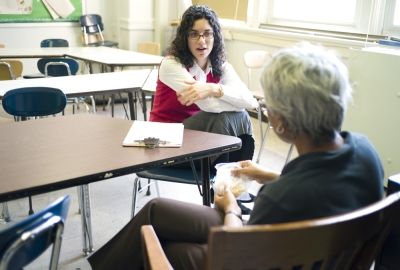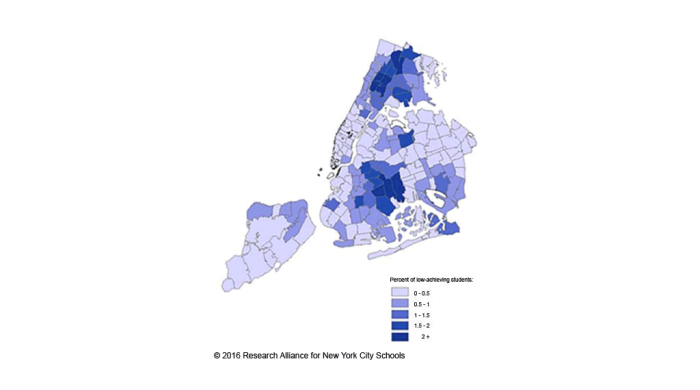
About High School Choice in NYC
New York City is home to the largest high school choice program in the country. Since 2004, all City 8th graders have been required to rank their 12 preferred high school programs (in 2014-2015, there are over 700 programs offered in 400 schools). The NYC Department of Education then matches each student with a school, based on the student’s preferences and other criteria (depending on a particular school’s admission method).
Previous work conducted by the Research Alliance found that, on average, low-performing middle school students are matched to high schools that are lower quality than those of their higher-achieving peers. Importantly, this gap is due in part to differences in students’ initial choices: While students of different achievement levels were equally likely to be matched to their first-choice school, low-achieving students were more likely to rank low-quality schools among their top choices. More recent analyses by our team revealed that low-income students at all achievement levels choose lower-quality schools than their more advantaged counterparts—a difference that is likely to some extent due to the limited number of high-quality school options available in low-income neighborhoods.
Together, these findings suggest that disadvantaged students may benefit from more support as they navigate the high school choice process.
About this Study
The Research Alliance is supporting a project led by researchers at NYU, Seton Hall University, and Harvard University, which will test a set of interventions that aim to improve the high school choice process for low-income students by providing them with simplified and targeted information about their high school options. The interventions are being piloted in a set of middle schools in the 2014-2015 school year. In the fall of 2015, we will conduct a randomized controlled trial on a broader scale, assessing the impact of the interventions on students’ choices and placements. The questions the study addresses include:
- How do different types of decision supports affect low-income middle school students’ knowledge about high schools and high school quality?
- How do these tools affect students’ actual high school choices and placements?
- To the extent that decision supports help students identify better schools for them, do they ultimately impact students’ academic outcomes and engagement in high school?
- How do students of varying backgrounds—such as achievement level or recent immigrant status—respond differently to provided supports?
- What explains variation or similarity in response to school choice supports, both across the type of support and across student characteristics?
We will randomly assign schools to receive one of three interventions (or to be in a control group) in order to rigorously estimate the effects of each treatment on student knowledge, school choices, and academic outcomes. Our research team will employ a mixed methods approach, combining surveys of staff, interviews with students, and an analysis of administrative data to better understand how and why these decision supports succeed or fail.
Supported by the William T. Grant Foundation, the Heckscher Foundation for Children, the Spencer Foundation, and the NYU Institute for Human Development and Social Change.
Related Publications
High School Choice in NYC
The New York City Department of Education’s recent efforts to improve high schools have in large part depended on a policy of choice, which enables families to select a school that they believe will best meet their child’s needs. This report examines the high school choices and placements of New York City’s lowest-achieving students, and assesses how these schools compare to those of their high-achieving peers. (2013)
How Does Concentrated Poverty Intersect with High School Choices?
This post shows the concentration of low-achieving 8th graders in specific, high-poverty areas of the City, and considers the implications for high school choice.
How Far Do NYC Students Travel to Get to School?
This Spotlight post uses geographic student and school location data to estimate commuting times for NYC’s elementary, middle, and high school students.
Journal Articles
Corcoran, S. P., Jennings, J. L., Cohodes, S., & Sattin-Bajaj, C. (2018). Leveling the Playing Field for High School Choice: Results from a Field Experiment of Informational Interventions. NBER Working Paper #24471.
Sattin-Bajaj, C., Jennings, J. L., Corcoran, S. P., Baker-Smith, E. C., & Hailey, C. (2018). Surviving at the Street Level: How Counselor's Implementation of School Choice Policy Shapes Students' High School Destinations. Sociology of Education, 91(1): 46-71.




